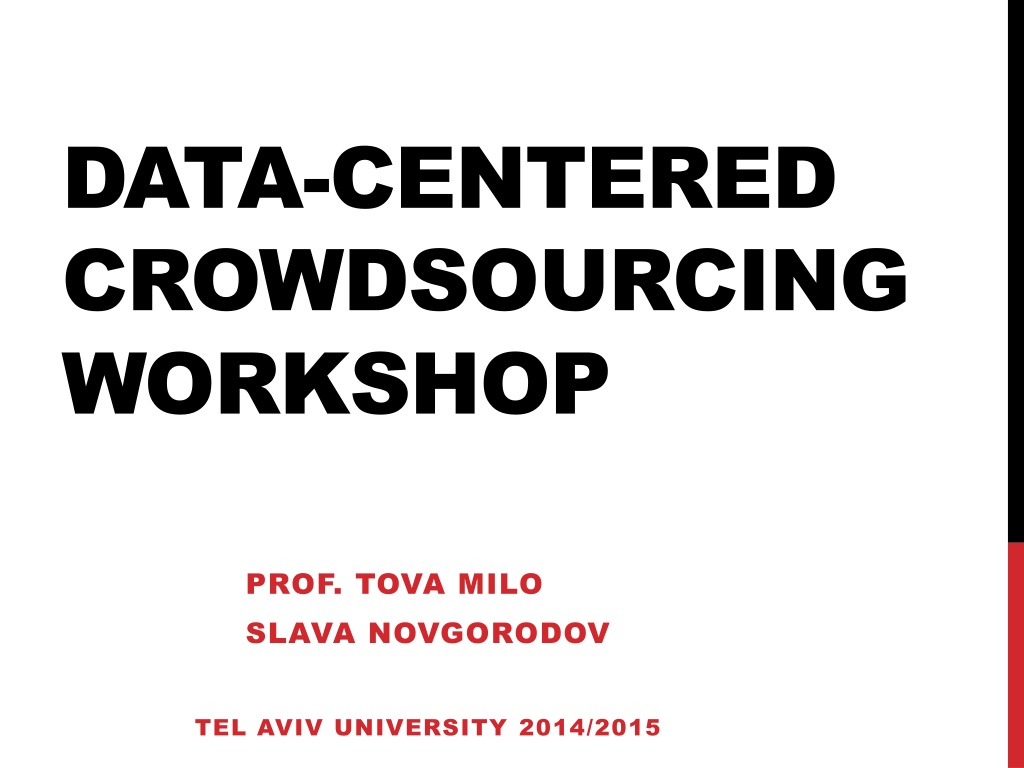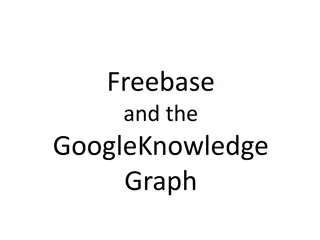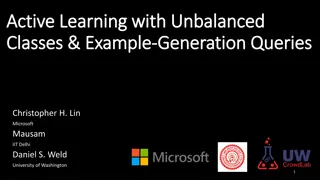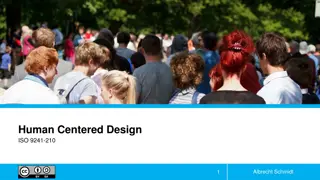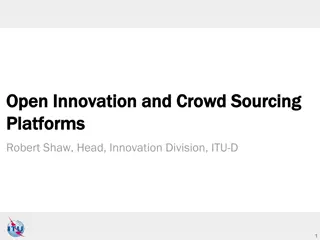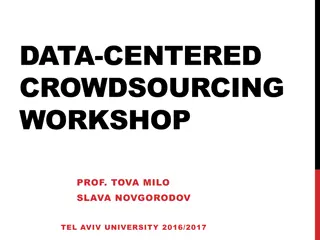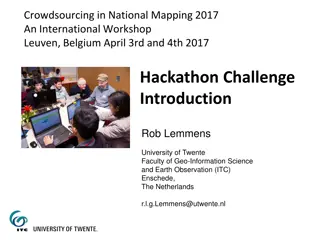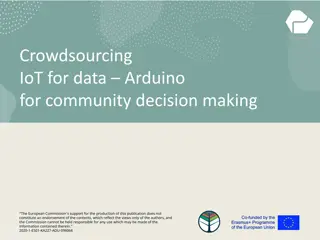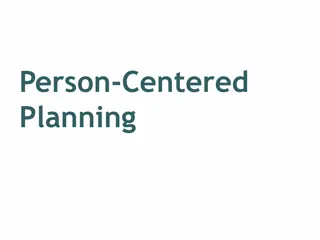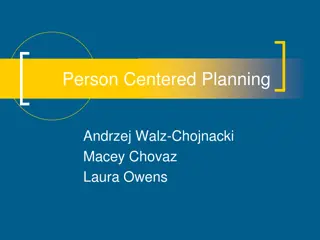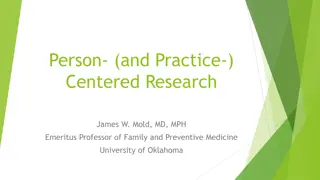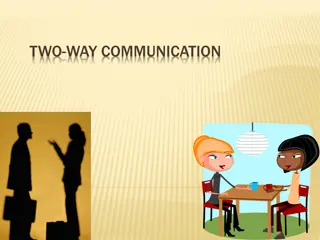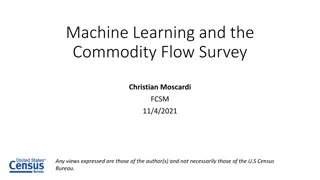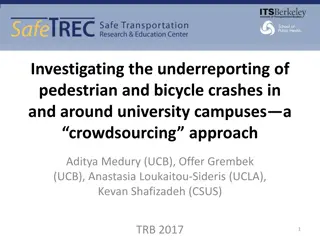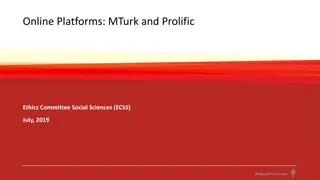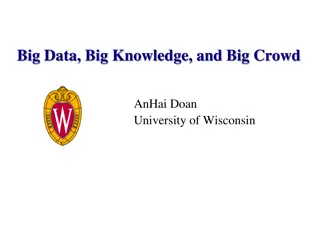Data-Centered Crowdsourcing Workshop Overview
In the data-centered crowdsourcing workshop led by Prof. Tova Milo and Slava Novgorodov at Tel Aviv University in 2014/2015, students work in teams of around 4 to develop projects focused on solving real-world problems using crowdsourcing. Projects can be application-based (web or mobile) or infrastructure-focused, with options spanning from tagging images to designing crowdsourcing platforms. The projects are to be presented at a demo day at the end of the semester, showcasing end-to-end demonstrations of the solutions created. Students have the freedom to choose their project topics and technologies, with support provided in web programming using PHP, JavaScript, and HTML.
Uploaded on Oct 09, 2024 | 0 Views
Download Presentation

Please find below an Image/Link to download the presentation.
The content on the website is provided AS IS for your information and personal use only. It may not be sold, licensed, or shared on other websites without obtaining consent from the author. Download presentation by click this link. If you encounter any issues during the download, it is possible that the publisher has removed the file from their server.
E N D
Presentation Transcript
DATA-CENTERED CROWDSOURCING WORKSHOP PROF. TOVA MILO SLAVA NOVGORODOV TEL AVIV UNIVERSITY 2014/2015
PROJECTS The team size is around 4 students and should be decided by the next week The projects should be done during the semester There is one touch-base meeting in a month and submission at the last week of the semester (demo day) The topic and the technology is up to you (we teach web programming using PHP, JavaScript and HTML and provide an SDK) The project should be interesting and solve real problem in the world of crowdsouring
PROJECTS In general there are two possible options for the projects: Application (Web or Mobile) an app that solves concrete problem using crowdsourcing (for example: Application for text translation) Infrastructure provides an option for application to integrate with it, and solves more general crowdsourcing problem (for example: Platform for matching users to questions/tasks) In both cases, students should prepare an end-to-end demonstration of their projects
CROWDSOURCING APPLICATION Possible options for applications projects: Tagging images (or in general: Adding metadata to multimedia content) using crowd Text translation, adaptation, shortening, improvement (TL;DR) Answering questions/queries using crowd Planning and scheduling with the crowd Geo-spartial applications based on crowd (use crowd locations to improve your data) Building knowledge base (incl. cleaning)
CROWDSOURCING INFRASTRUCTURE Possible options for infrastructure projects: Crowdsourcing platform design and implementation (AMTurk, CrowdFlower, ) Matching crowd users to questions/tasks (based on their preferences/test questions/performance) Payment and incentives model for crowd (solving the problem of trade-off between budget and quality) Budget management and payment strategies Ordering/Sequences of questions to crowd (session model and context) Spamming detection Load balancing
COLLECTING META-DATA FROM MULTIMEDIA Existing projects: The ESP game tagging images Tag a Tune audio annotation Squigl detect objects on images Verbosity a common knowledge trainer (game) More projects Games with a Purpose More ideas for projects: Video tagging, events detection using crowd
TEXT TRANSLATION Existing projects: Paper from UPenn by Zaidan & Callison-Burch Facebook localization was partially done by crowd GetLocalization.com TL;DR community Google translate improve translation feature More ideas for projects: Projects like English Wikipedia Simple English Wiki
ANSWERING QUESTIONS AND QUERIES WITH CROWD Existing projects: StackOverflow TripAdvisor Yahoo! Answers A lot of academical research to make such projects more structured and focused (OASSIS, AskIt, ) More ideas for projects: Free text to queries translation (using crowd) Meta-queries
PLANNING WITH CROWD Existing projects: CrowdPlannr (academical research, TAU) CrowdCierge (also academical, MIT) More ideas for projects: Events planning Schedule Suggestions Work split and sharing Better (more general) CrowdPlannr
GEOSPATRIAL CROWD APPS Existing projects: Scores & Video city maps soccer fans visualization Waze OpenStreetMaps collaborative mapping More ideas for projects: Wikipedia missing photos If there is a missing photo of some place, you can ask user to upload it (if he is currently there) Geo-based tasks and job sequence planning Crowd-based layers over existing maps
BUILDING KNOWLEDGEBASE Existing projects: YAGO (academical, not crowdsourcing) OASSIS (academical, crowd minning) QOCO (academical, query-oriented) More ideas for projects: Building database of popular facts (common knowledge) Building database of rare /not documented facts Enrich datasets with semantics Combine multipledatasets
CROWDSOURCING INFRASTRUCTURE Possible options for infrastructure projects: Crowdsourcing platform design and implementation (AMTurk, CrowdFlower, ) Matching crowd users to questions/tasks (based on their preferences/test questions/performance) Payment and incentives model for crowd (solving the problem of trade-off between budget and quality) Budget management and payment strategies Ordering/Sequences of questions to crowd (session model and context) Spamming detection Load balancing
CROWDSOURCING PLATFORM Existing projects: Amazon Mechanical Turk (microtasks) CrowdFlower oDesk (for big projects) More ideas for projects: Better management panel Better connection to users
MATCHING CROWD USERS TO QUESTIONS/TASKS The matching can be done based on: User preference Requester preference ( Give me 5 people from US, that are experts in baseball ) Qualification tests More?
PAYMENT AND INCENTIVES Create the real free market: Bidding Monopoles and workers unions Long-term contracts Quality / Payment tradeoff
BUDGET MANAGEMENT Easier way to manage your workers Algorithmic budget allocation Manual preferences Better UI (control panel)
ORDERING OF TASKS Crowd users have different preferences Many tasks of the same type Many tasks in the same context Different tasks Easy-Only (less money per tasks more tasks) Difficult-Only Mixed
SPAMMING DETECTION Detect spammers Don t hurt real crowd (can cost you reputation) Provide high quality and low latency
LOAD BALANCING The tasks should be done by all the crowd There are many strong crowd users, and many requesters willing to get them Not always available
